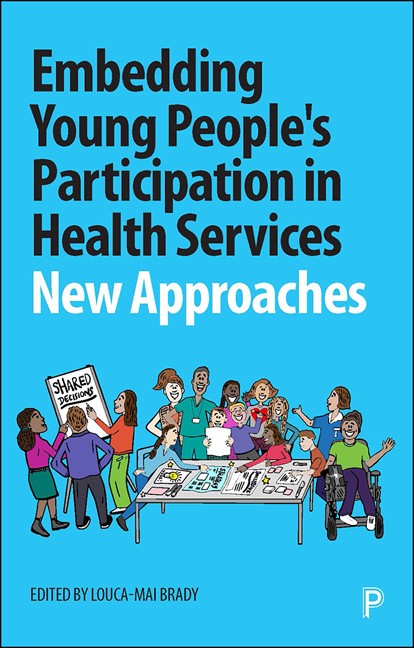Book contents
- Frontmatter
- Dedication
- Contents
- List of Boxes, Figures and Tables
- Summary
- Notes on Contributors
- Acknowledgements
- Foreword
- Introduction: Embedding Young People’s Participation in Healthcare
- PART I Young People’s Participation in Individual Decision-Making
- PART II Participation in National Projects and Programmes
- PART III Collaborative Research in NHS Services
- PART IV Young People-led Participation
- Index
9 - RAiISE: Advocating for Young People With Invisible Illnesses
Published online by Cambridge University Press: 25 February 2021
- Frontmatter
- Dedication
- Contents
- List of Boxes, Figures and Tables
- Summary
- Notes on Contributors
- Acknowledgements
- Foreword
- Introduction: Embedding Young People’s Participation in Healthcare
- PART I Young People’s Participation in Individual Decision-Making
- PART II Participation in National Projects and Programmes
- PART III Collaborative Research in NHS Services
- PART IV Young People-led Participation
- Index
Summary
Introduction
In this chapter, we discuss RAiISE (Raising Awareness of invisible Illnesses in Schools and Education), a charity founded in the United Kingdom that is led by young people, for young people. From the perspective of the Chief Executive Officer (CEO) and the Board of Trustees, all of whom have lived experience of invisible illnesses themselves or as a parent/carer, we will provide insight into day-to-day life for the charity and its unique journey from an initial idea of one young person diagnosed with a chronic health condition to a national organisation with a global presence. RAiISE is a positive example of young people leading health and wellbeing initiatives with the support of healthcare and education professionals, rather than simple instances of young people's engagement or involvement. It also highlights the importance of collaboration across sectors, including schools and charities, to ensure that young people with health conditions are adequately supported, acknowledging the wider impact of health on a young person's life – away from the hospital. In this chapter, we will refer to ‘invisible illnesses’, which for context, is an umbrella term for any health condition that isn't easily visible to others. This includes chronic conditions such as cystic fibrosis, diabetes, inflammatory bowel diseases and musculoskeletal diseases, among others – but also mental health illnesses such as anxiety, depression and schizophrenia. RAiISE attempts to be as inclusive as possible in reference to invisible illnesses and equally helps to place the spotlight on visible illnesses affecting young people too.
What matters to us: young people's perspective on participation in healthcare
The importance of young people's involvement in healthcare is undeniable, and recent years have shown a positive increase in the inclusion of young people's voices in decision-making processes in healthcare (Weil et al, 2015). While there are discussions in both child and adult healthcare, it is important to acknowledge that there is no distinct line or ‘cut-off’ between childhood and adulthood, and the ways in which these groups engage with healthcare, despite organisational and legal definitions of who is defined as a child or adult. Therefore, the ‘young person’ demographic must have a place to voice their own unique experiences and concerns of healthcare, which indeed differs from younger children and older adults with health conditions (Betz et al, 2013).
- Type
- Chapter
- Information
- Embedding Young People's Participation in Health ServicesNew Approaches, pp. 231 - 248Publisher: Bristol University PressPrint publication year: 2020

